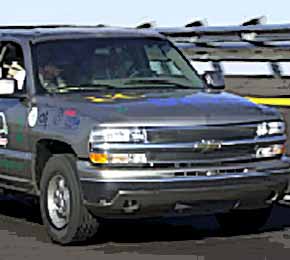|
Plug-In
Hybrid Electric Vehicles - PHEVs
|
|
Plug-in hybrid electric
vehicles (PHEV) help extend the range of the common hybrid
car, truck, van or whatever.
For the past several
years a small group of forward-thinking automotive engineers
have been figuring out how to squeeze the most mileage
out commercially available hybrids.
Because of their work,
Toyota and General Motors are now developing plug-in hybrids,
expected to be demonstrated in 2007.
|
Let's Be Frank
One such person is Dr. Andy Frank, Director of the UC Davis
Future Automotive Technology and Engineering Center for Hybrid
Electric Vehicles. Professor Frank along with Dr. Paul Erickson,
run the Team Fate group, which is an advanced
Hybrid Vehicle research group at the University of California
at Davis.
Dr. Frank advocates for plug-in (grid-connected) Hybrid Electric
Vehicles or PHEV's. The difference between the PHEV and the
regular HEV is that the battery pack on the PHEV is optimized
for greater range. In addition, the battery pack for the PHEV
can be plugged in to an outlet in your garage for overnight,
off-peak charging.
Longer ranges (80-250 mpg) and less fuel consumed and less
toxins put into the environment are the main advantages.
Some would argue that plugging in a vehicle to a household
outlet would mean the electricity would have to come from
another source and not necessarily a clean one. Most electricity
now days is generated by a combination of sources, from
the burning of fossil fuels, to solar, wind and hydroelectric
power to nuclear generation plants. With recent advancements
even the fossil fuel burning plants produce less pollution
than what comes out of a comparable number of automobile
tailpipes.
Engineering Feat
Another pioneer in the PHEV field is the California
Cars Initiative. With the help of Felix Kramer,
Founder and Technology Lead Ron Gremban plus a group of
dedicated electrical engineers from Corte Madera, California,
the Initiative has figured out a way to squeeze 80 mpg out
of a production model Toyota Prius by utilizing 18 brick-size
batteries stack in the trunk.
According to an Associated Press article, Gremban says,
"The value of plug-in hybrids is they can dramatically
reduce gasoline usage for the first few miles every day.
The average for people's usage of a car is somewhere around
30 to 40 miles per day. During that kind of driving, the
plug-in hybrid can make a dramatic difference."
Drive For Success
A company called EDrive
Systems, based in Monrovia, California is offering
the first and only commercially available PHEV retrofit
hybrid system. Their system is currently only available
for the Toyota Prius, but retrofitting for other models
is currently under development. The EDrive system replaces
the existing Prius NiMH battery and Toyota battery control
computer with a larger Valence Saphion lithium-ion battery
and a proprietary battery monitoring and control system
developed by EnergyCS. The new system allows the Prius to
be charged at home using a standard 110/120V home outlet.
Averages of 100 mpg and upwards can be expected on this
system.
According to EDrive Systems, "EDrive Systems LLC aims
to prove the concept for those early adopters willing to
show the world that vehicles can be renewably powered without
compromise and that we can move towards a cleaner, more
renewable future. Many others may choose PHEV's as a solution
that can be powered by U.S. energy sources without paying
the hefty price of supporting countries that might not have
our best interests in mind."
Many automobile manufacturers have been reluctant to develop
their own PHEV programs, not wanting confuse consumers with
the message that hybrid vehicles don't have to be plugged
in to work (a big selling point for most). The entrepreneurs
on the leading edge of automotive technology however as
making the big automakers take notice. With ever-rising
gasoline prices and the right marketing strategy, plug-n-play
hybrid vehicles may just be a commercial reality sooner
than we think.
Toyota recently has reversed their position on plug-in electric
hybrid vehicles saying that they now intend to develop one or
more such vehicles. With pressure from Team Fate and the California
Cars Initiative along with the fact that DaimlerChrysler is
starting to deliver plug-in hybrid electric vans to large companies,
Toyota has stated its desire to lead the consumer car market
with plug-in vehicles. This has started to create a domino effect
as GM is also developing a plug-in hybrid vehicle in order to
keep up with Toyota and DaimlerChrysler.
General Motors formally announced at the 2006 Los Angeles Auto
Show that it is developing plug-in hybrid capabilities to be
part of its Green Line Vue vehicles. The Green Line with plug-in
hybrid capabilities will be available in 2008. GM's North American
president, Troy Clarke has boldly predicted that the Green Line
Vue SUV plug-in hybrid will get 70 mpg.
For further information see Significant
Market Potential and CalCars.org
as both of these sites provide insight and important info
regarding the future of the PHEV.
|


